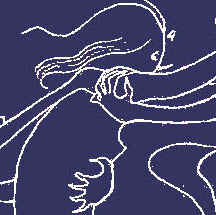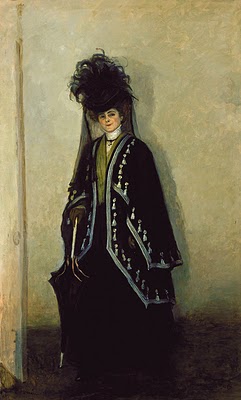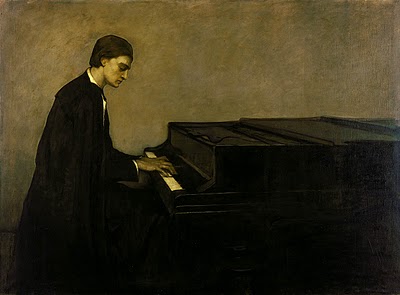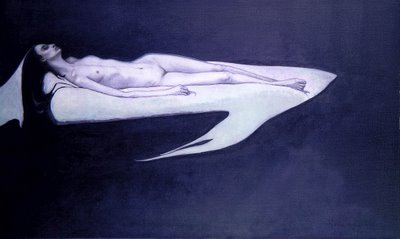Brooks and her Contemporaries
The common link between all the images discussed on this page is their continuous contour line or, as Brooks described it, "the inevitable encircling line." 1While the art world during the second decade of the twentieth century was inundated with a variety of new trends in visual representation, Brooks’ drawings were unaffected by the new forms of artistic expression.Symbolism and Art Nouveau were two styles that were at their height during Brook’s formative years and therefore could have been influences on the artists. Additionally, her exhibition at the Galeries Durand-Ruel was held in 1910, the same year that cubism began to stand for the new art in Paris.Evidently she was not concerned with the trends developed during her youth or those discussed within the artistic circles of Matisse and Picasso.In a comparison study of the work of Romaine Brooks and Picasso, Bridget Elliott points out that in early twentieth century France, Brooks, basically missed "the avant-garde boat" 2, or in all probability refused to get on board. She cites their class situation as the reason for this discrepancy, "Picasso belonged to the experimental avant-garde of the Left Bank and Brooks to the high society world of the Right Bank," and… "never the twain shall meet." 3
A Glance at Brooks' Paintings
Brook’s style was unwavering, if not more disciplined and more determined than ever.Furthermore, her allusion to the subconscious nature of her works strongly suggests if anything, the influence of Surrealism.In an interview with the artist Breeskin recorded the process Brooks went through when she sat down to draw.
"The artist once mentioned that as she poised her pencil over the paper she had no idea what would evolve. As if hypnotized by the very act of drawing she summoned up aspects of her past, the better to understand the nature of human fear and loneliness."4
Moreover, in her 1935 exhibition catalog for The Arts club of Chicago Brooks wrote,
"The surety of outline and apparent freedom from technique are the unconscious evolution from a more material and direct form of art.” "5

"No Pleasant Memories"
Quotes from the unpublished memoirs of Romaine Brooks
With the increased interest in psychology and the analysis of dreams that developed as a result of the contemporary writings of Freud, the establishment of a direct connection to Surrealism is difficult to avoid, especially in light of the statements above. Regardless, most art historians agree Brooks’ works were exclusively her own. According to Chastain,
"Brooks was not directly influenced by the philosophy of Andre Breton and his circle, at the most fundamental level she tapped into a source that influenced their thinking- the new interest in psychology and the subconscious." 6
Overall, Brooks was aware yet unheeding of the new pictorial languages that developed throughout her artistic career.
While her drawings allowed her to stand out, her skillfully painted portraits, based solely on observation and precision enabled her to blend in with the high society described by Elliot above. Some of her most well-known portraits depict powerful aristocratic women of her circle such as Madame Errázuris (c. 1908, above slideshow), Princess Lucien Murat (c. 1910), and Madame Legrande at Longchamp Racecourse (c. 1912). Images of accomplished women were also common such as, Miss Natalie Barney, “L’Amazone,” (c. 1920, above slideshow) depicting the established poet and novelist, and Renata Borgatti au piano (c. 1920, above slideshow) depicting the famous pianist as she plays. Each painting portrayed a powerful, independent woman, a veritable "Amazon" in their respective circles and fields. Surprisingly, the two mediums rarely displayed conceptual similarities. According to Joshua Taylor, the Director of the National Museum of American Art in the late 1970s, Brooks was torn, "between drawings to dream by and paintings to see by." 7 There is only one image in her entire oeuvre of paintings that combines the imaginative and linear qualities of her drawings with her meticulous and realistic approach to painting.
La Trajet or The Crossing (c. 1900; above slideshow) is a breathtaking image of the Russian dancer and actress, Ida Rubinstein who appears in the nude, floating on a white wing-like sail in an undifferentiated void. As an allegory for death, simple contour lines define her lifeless body and the blackness of the void not only poses a stark contrast to the figure but completely envelopes her. Once again the feeling of entrapment prevails as if to solidify her fate. For Brooks, Ida was the embodiment of strength in femininity but stripped bare and placed in this dark and foreboding environment, the vulnerability of this image betrays everything her portraits stood for. Such exposure is only evident in Brooks’ introspective drawings making this work a rare example of her two distinctive artistic mediums merging together.
Conclusion
Romaine Brooks was a gifted painter and draughtsman who outwardly created beautiful portraits but inwardly used her drawings to tell her story. The minimalist lines of her drawings shared her ongoing struggle with her mother, her brother, and eventually the demons that they left behind. Her drawings fluctuated between autobiography and imagination as her afflicted psyche poured onto the pages, hanging the dirty laundry of her life, out to dry.The contour lines of her images are severe and determined, translating her emotional battles onto paper. Even though her artwork was her release and her attempt to escape the haunting world around her, it is obvious from her work that she never truly broke free. If not the confined images, then the continuously encircling effect of the medium she chose confirms this suspicion. Mostly written at the same time, her memoirs accompany these works and shed light on these mysterious images. Vivid passages from the text shows the direct relationship of her life on her creative outlet of drawing. While we may be able to liberate their message, the figures continue to remain entrapped within her mesmerizing lines. According to Elsa Smithgall "Drawings are…fresh records of the direct encounter of the artist with his or her subject. More than simply an objective transcription, drawings are fueled by the imagination and feeling…a drawing has the remarkable ability to convey emotion through the barest and most limited of means."8 She may not have been talking about the works of Romaine Brooks, but there is no question that this is the exact effect that Brooks achieved. Further investigation of her works is necessary to understand her entire collection, but for now, her story has been told between the lines of these incredible drawings.
Footnotes
Breeskin. Romaine Brooks. 38. Originally written in Catalog of an Exhibition of Original Drawings by Romaine Brooks (Chicago: The Arts Club of Chicago, 1935).↑
Bridget Elliott. “Deconstructing Modernism; Allegories of Regeneration in Brooks and Picasso.” In Chadwick, Whitney and Latimer, Tirza True, eds. The Modern Woman Revisited: Paris Between The Wars. New Brunswick, NJ. : Rutgers University Press (c.2003): 35. ↑
Bridget Elliott. “Deconstructing,” 37. ↑
Breeskin. Romaine Brooks. 43. ↑
Breeskin. Romaine Brooks. 38.Originally written in Catalog of an Exhibition of Original Drawings by Romaine Brooks (Chicago: The Arts Club of Chicago, 1935). ↑
Chastain. “A New Looks at Her Drawings.” 10. ↑
Breeskin, Romaine Brooks, in Introduction written by Joshua C. Taylor, 15. ↑
Elsa Smithgall. “French Drawings from the Aaronsohn Collection.” Estate of Stuart Davis/Licensed by VAGA, New York, NY (2012): 2. ↑





